Abstract
Objective
Develop a conceptual computational agent-based model (ABM) to explore community-wide versus spatially focused crime reporting interventions to reduce community crime perpetrated by youth.
Methods
Agents within the model represent individual residents and interact on a two-dimensional grid representing an abstract community. Juvenile agents are assigned initial random probabilities of perpetrating a crime and adults are assigned random probabilities of witnessing and reporting crimes. The agents’ behavioral probabilities modify depending upon the individual’s experience with criminal behavior and punishment, and exposure community crime interventions. Cost-effectiveness analyses assessed the impact of activating different percentages of adults to increase reporting and reduce community crime activity. Community-wide interventions were compared with spatially focused interventions, in which activated adults were focused in areas of highest crime prevalence.
Results
The ABM suggests that both community-wide and spatially focused interventions can be effective in reducing overall offenses, but their relative effectiveness may depend on the intensity and cost of the interventions. While spatially focused intervention yielded localized reductions in crimes, such interventions were shown to move crime to nearby communities. Community-wide interventions can achieve larger reductions in overall community crime offenses than spatially focused interventions, as long as sufficient resources are available.
Conclusion
The ABM demonstrates that community-wide and spatially focused crime strategies produce unique intervention dynamics influencing juvenile crime behaviors through the decisions and actions of community adults. It shows how such models might be used to investigate community-supported crime intervention programs by integrating community input and expertise and provides a simulated setting for assessing dimensions of cost comparison and intervention effect sustainability. ABM illustrates how intervention models might be used to investigate community-supported crime intervention programs.
Keywords: community crime, agent based modeling, community engagement, intervention evaluation
INTRODUCTION
In the United States, violence and crime disproportionately impacts young people living within low-income disadvantaged communities. Violence is the second leading cause of death for all youth ages 15-24 and the leading cause of death for African American youth in this same age range (Centers for Disease Control and Prevention, 2011). Juveniles accounted for 16% of all violent crime arrests and 26% of all property crime arrests in 2007 and after years of decline, the juvenile arrest rate for Property Crime Index offenses increased 9% between 2006 and 2008 (Puzzanchera, 2009). While consistent reductions in community crime and violence have been documented over the past decade, juvenile crime, violent crime and victimization continue to be a critical issue of concern in public safety and health of communities, locally and nationally alike (Centers for Disease Control and Prevention, 2011). Many have come to recognize violence and crime as a public health epidemic and have turned to public health tools of epidemiology to characterize relationships of risk and protective factors with the physical and social environments (Ellickson, McCaffrey, Ghosh-Dastidar, & Longshore, 2003; Office of the Surgeon General (US); National Center for Injury Prevention and Control (US); National Institute of Mental Health (US); Center for Mental Health Services (US), 2001).
While interventions addressing juvenile crime and violence often focus upon youth, the role and influence of community context continues to garner attention. An ecological framework recognizes that it is the interaction of multiple hierarchical levels including individual, relationship, community and societal-level factors influence the risk and protective dynamics associated with community crime and violence (Bronfenbrenner, 1979; Resnick, Ireland, & Borowsky, 2004; Sampson, Raudenbush, & Earls, 1997). The early work of Shaw and McKay (1942) found that social and structural risk factors such as poverty, unemployment, residential mobility and instability were found to be correlated with patterns of juvenile offending. Efforts to further examine the influence of factors beyond the individual are necessary for effectively addressing the range of risk factors associated with youth violence and crime (Kellermann, Fuqua-Whitley, Rivara, & Mercy, 1998; Resnick et al., 2004).
In an effort to reduce crime by addressing social and structural instability, comprehensive community mobilization interventions such as community block watch programs were developed and in certain conditions have shown to reduce crime and violence (Holloway K, 2008). The objective of community block watch programs is to counter the isolation and separation that crime creates by cultivating community social bonds and improving the interaction with the police. Developing and evaluating complex community-based crime interventions presents a variety of methodological, statistical and economic challenges (Dietz, 2002). While some community-level crime prevention approaches have shown evidence of effectiveness, these approaches are often expensive, difficult to sustain and evaluate due to challenges in translation and replication to multiple settings (Holloway K, 2008). Results from the Department of Justice Block Watch Program Assessment meta-analysis found that crime decreased by 16 percent in the experimental areas (i.e. block watch) compared with the control areas(Holloway K, 2008).
Agent-based models (ABMs) comprise a class of computational modeling tools that has received increased attention from public health researchers interested in understanding and exploring complex problems. ABMs have been used increasingly in the social sciences since the 1990s as a means of understanding social processes and dynamics (Burke et al., 2006; Gorman, Mezic, Mezic, & Gruenewald, 2006). The method has proved especially useful in understanding complex social dynamics in a variety of health areas (e.g., immunization and school closure policy) by integrating an ecological systems approach with interactions between micro- and macro-level processes (Brown et al., 2011; Lee et al., 2011; Lee, Brown, Cooley, Potter, et al., 2010; Lee, Brown, Cooley, Zimmerman, et al., 2010; Lee, Brown, Korch, et al., 2010). Utilizing ABM techniques provides a uniquely valuable and cost-effective opportunity to develop, evaluate and implement behavioral interventions in a dynamic simulated environmental context. The simulation is based upon the characteristics of real-life settings and theory informed interventions, and the diverse expertise of local community, academic, political and organizational stakeholders. Modeling and dynamic simulation using synthetic societies provides the ability to evaluate potential community intervention, integrate theoretical constructs at low-cost, and facilitate interdisciplinary collaboration and partnership. Previous ABMs have been developed to explore dynamics of criminal activity but not the modeling of different interventions to reduce community crime and violence (Dray A, 2008; Epstein, 2002; Furtado, 2008; Groff, 2008).
The goal of the current work is to provide a conceptual analysis of fundamental comparison and trade-offs among alternative interventions to reduce community crime, informed by key behavioral and community factors associated with neighborhood mobilization and watch programs. Our specific aims are: 1) to explore the relative impact of alternative community-level crime interventions (i.e., spatially focused compared with community-wide strategies), and 2) to illustrate the contagion dynamics and differential cost associated with alternative community-level crime intervention approaches. To address these aims, we have developed a conceptual ABM that includes only the essential features of potential witnesses and potential offenders interacting in an abstract community environment. This conceptual model will be used to examine some general characteristics of the dynamics of alternative community crime interventions, and to lay the foundation for future models that can further examine these issues in the context of a specific spatial and demographic setting.
METHODS
An agent-based model was developed in the NetLogo programming language that included potential offenders and potential witnesses interacting within an abstract community. The community was represented by a two-dimensional toroidal grid, with one or more agents occupying any location in the 100 × 100 grid. The community was further subdivided into nine square blocks. The abstract community was populated by two kinds of agents: adults and juveniles. The baseline model included 1000 agents, with 90% of the agents being adults and 10% juveniles. For each run of the model, agents were spatially distributed at random locations through the community. Each run of the simulation thus followed a different dynamic trajectory via the interactions of the agents in the community.
The model proceeded in time steps corresponding to one day. Fig. 1 presents the daily time-step of agents within the ABM. Adults remained stationary at what was considered their place of residence. Juveniles could choose to move around within the entire community. Both adults and juvenile observed the actions of other agents within their immediate vicinity. During each simulated day, the behavior of each agent was determined by a few probabilistic rules. Juveniles could decide whether to commit an offense and could also decide whether to move in a given direction. Juveniles were assigned individualized initial probabilities of committing offenses. Juveniles became more or less inclined to commit offenses depending on their experience with being reported by adults in the community. In particular, given the interest in modeling the internal decision making processes for adult and juvenile agents, the behavioral parameters of the agents is guided by the Theory of Reasoned Action (Ajzen, 1980; Mulvey et al., 2004): if perceived reward > perceived risk, then action is taken. Each juvenile’s initial perceived reward was assigned randomly to individuals and subsequently changed depending on the individual’s experience. Likewise, perceived risk depended on the individual’s own experience and exposures as the model is run.
Figure 1.
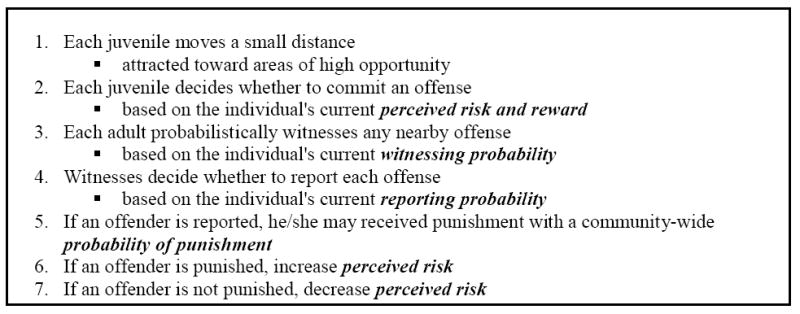
Daily Time-Step of Agents within the Agent-Based Model
Initial behavioral probabilities were assigned randomly to juveniles in the model based upon the data available within the Pathways to Desistence Study (PDS) (Mulvey et al., 2004), following a systematic calibration process of the ABM utilized in the study. Behavioral choices of juveniles in the model were compared with and calibrated to conform to behavioral juvenile crime related decision making observations documented by Mulvey (2004) in their longitudinal survey of N = 1,354 active juvenile offenders over a three-year period of time in multiple urban sites in the U.S. The PDS collected data from juveniles nationally who had committed a variety of crimes using self report survey measures of frequency of offenses, perceived rewards and perceived risks associated with the offenses committed. Subsequent analyses were conducted to examine differences in risk perception based on prior offending experience. The calibration of the ABM to the PDS is shown in Figure 2. Key observations in the PDS included: (Observation 1) the most frequent juvenile offenders perceived significantly less risk and more reward from crime than those with medium frequency of offenses; (Observation 2) less frequent juvenile offenders perceived significantly more risk and less reward; (Observation 3) juveniles decrease the level of perceived risk when offending is undetected or avoids punishment; (Observation 4) individuals tend to increase the level of perceived risk when they are arrested; and finally, (Observation 5) as juveniles age, perceived reward appears to decrease for all levels of offender frequency.
Figure 2. Model Calibration.
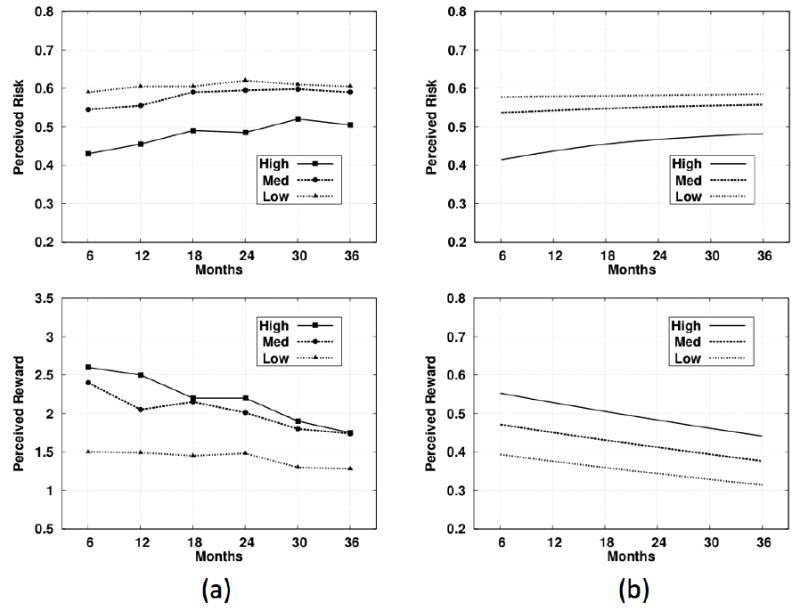
(a) Survey data on as reported by (23). Subjects were grouped into three groups (High, Med, Low), based on arrest frequency. The highest frequency group had the greatest increase in perceived risk over time, as well as the greatest decrease in perceived reward. (b) Results of calibrating the model, with final results of coefficients a = 0.0002, b = 0.005, and c = 0.00025 in rules R1 and R2 in main text. Juvenile agents were divided into three groups (High, Med, Low), based on arrest frequency after calibration. Patterns of perceived risk and reward qualitatively match the observed data over a 36 month simulated period. Note that the range of values on y-axis in the observed data correspond to reported survey responses, while the y-axis in the simulation are operational risk/reward values used by agents to weigh the desirability of committing offenses.
In order to capture similar behaviors in the model, we developed parameterized rules to change the behavioral probabilities of juveniles based on their experience. The first rule specifies what happens when an individual i commits an offense at time t:
-
R1: Risk(i, t+1) = (1 – a) Risk(i, t) if the offense is undetected or avoids punishment
Risk(i, t+1) = (1 + b) Risk(i, t) If the offense is punished
A second rule reflects the effects of age:
R2: Reward(i, t+1) = (1 - c) Reward(i, t)
The parameters a, b, and c were selected by a search process over the range (0, 0.01) so that the resulting behavior of the juveniles in the model satisfied Observations 1-5 above and qualitatively matched the survey results in the PDS (Fig. 2). The calibrated parameters had values: a = 0.0002, b = 0.005, and c = 0.00025.
Once rules R1 and R2 were calibrated, the juveniles in the model were observed to match the PDS data, in the sense that if an individual committed an offense and was punished, that individual’s perceived risk increased. On the other hand, if an individual committed an offense and was not punished, that individual’s perceived risk decreased. In addition, behavioral rules were added so that juveniles could also observe the frequency at which crimes were being reported in their immediate surroundings, and they tended to move in the direction of higher unreported crime.
The model characterized two phases of adult behavior: First, how likely was the adult to witness crime in the community? Second, how likely was the adult to take action by reporting a crime that was witnessed? To model these two behaviors, adults were assigned individualized initial probabilities of witnessing nearby offenses, as well as individualized initial probabilities of reporting offenses that they witness. Both probabilities were drawn from uniform random distributions, such that approximately 50% of incidents were witnessed and 50% of witnessed incidents were reported. In the absence of better data, we assumed that the initial probability of witnessing an offense was independent of the initial probability of reporting an offense for each adult. We also explored an alternative model in which these two probabilities were linked, and found that the relative outcomes of the interventions discussed below were not significantly affected.
Visualizations
The NetLogo system provides a visualization of the model as it runs, facilitating the process of verifying that the computational implementation corresponds to the intended conceptual model. A close-up illustration of agents interacting within the model is shown in Fig. 3. A bird’s-eye view of the model is shown in Fig. 4, in which areas are shaded according to the level of recent criminal activity. The interested reader is invited to contact the corresponding author to obtain a working version of the program.
Figure 3.
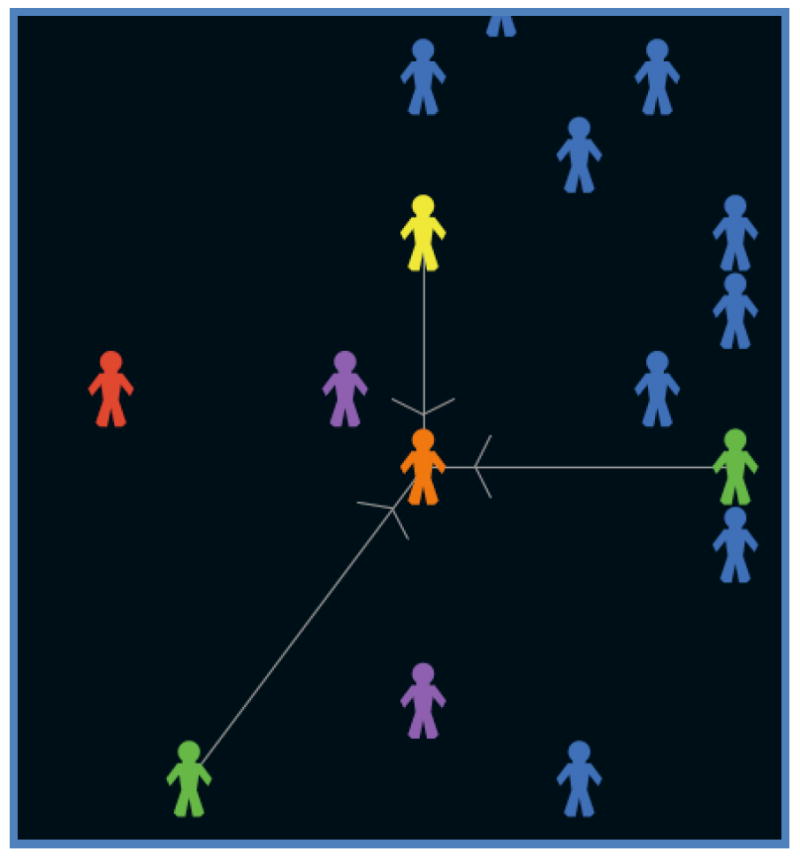
A close-up view of agents interacting in the model: The color of agents indicate their current activity: juveniles who have not offended on the current time step are purple; offenders who have not been reported are red; offenders who have been reported and will be punished are orange; adults who witness an offense and report it are green and an arrow points to the offender who has been reported; adults who witness an offense but do not report it are yellow; adults that have not witnessed an offense on the current time step are blue.
Figure 4.
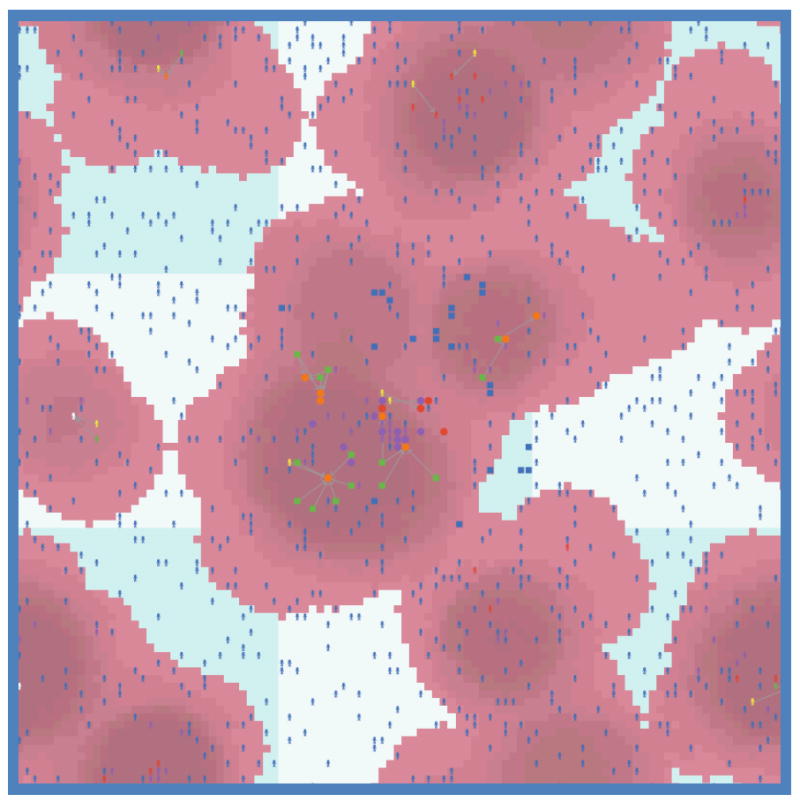
A bird’s-eye view the model showing a snapshot of the model after a spatial-targeted intervention just left of center in the figure. Areas are shaded according to the level of recent criminal activity. Activated adults are represented by squares, and juvenile offenders who being reported by activated adults are indicated by circles, with colors as explained in Fig. 3.
Modeling of Community Interventions to Prevent Juvenile Crime
The conceptual model included possible community interventions that alter the witnessing and reporting behaviors of adults in the community. We focused on how changes in a given percent of adults might affect overall crime patterns as follows: we assumed that if a community intervention occurred, then some fraction of the adults became activated. An activated adult agent represented a resident who had become attentive to possible crime in the community and had also become primed for action. Activated adult agents always witnessed any nearby crime, and always reported any crime they witness.
Two kinds of community-based interventions were modeled: community-wide and spatially focused. In a community-wide crime intervention, a certain fraction of the adults in the community were randomly selected from the entire community to be activated. In a spatially focused community-based crime intervention, a certain fraction of the adults were activated, but the activated adults were all selected from the block having the highest prevalence of crime. For each type of intervention, we defined the intensity of the intervention as the fraction of adults in the entire community who were activated. For example, an intervention with intensity level 5 meant that 5% of the adults were activated. By using a fixed level of intensity the model allowed us to explore the differential effects of community interventions that required the same level of resources, but which deployed those resources differently within the community. Comparisons of community-wide and spatially focused interventions also addressed the “contagion” effects that result from focusing a community intervention on a localized region: that is, would the offenders simply move to other communities?
Models enable us to explore the relative cost effectiveness of alternative intervention strategies before implementation. As a preliminary cost-effectiveness analysis, we assumed that the costs of an intervention program were proportional to the number of adults activated by the intervention. (This assumption may overestimate costs in practice; for example, some adults become activated spontaneously through the behavior of their neighbors.) We also defined the effectiveness of intervention as the number of offenses averted:
The spatially explicit nature of the model enables us to explore the phenomenon of “crime contagion”: the geographical spread of the incidence of offenses that may result from community intervention (Ellickson et al., 2003; Office of the Surgeon General (US); National Center for Injury Prevention and Control (US); National Institute of Mental Health (US); Center for Mental Health Services (US), 2001). The contagion of crime was quantified by the fraction of offenders who had relocated the site of their offenses from the block where they offended at the time the intervention began to a different block by the end of the simulation.
The computational model is a stochastic simulation, so that different results were observed for each run of the model. Therefore, multiple runs were performed in order to collect statistics to evaluate the various community intervention strategies. For community-wide and spatially focused interventions, the model was run 50 times for each intensity level. As a control, we also ran the model with no intervention 50 times. The results presented reflect the means and standard deviations of measurements over all runs of the model.
RESULTS
Impact of community intervention strategies on community crime
Table 1 shows the results of the conceptual agent-based model, reporting the mean and standard deviations of the total number of offenses that occur after the start of each given intervention over 50 runs at each intervention level. As might be expected, a dose-response relationship was observed between the number of activated adults in the community and the total number of offenses: the larger the percent of activated adults, the greater the decrease in juvenile crime. In each row, the entries for the community-wide or spatially focused intervention all represent a statistically significant (p-value < 0.05) decrease compared to the control (No Intervention).
Table 1. Offenses after Intervention.
| Pct Activated | No Intervention | Community-wide | Spatially focused |
|---|---|---|---|
| 0.25 | 5795.9 (566.18) | 5743.8 (550.79) | 5713.6 (574.18) |
| 0.5 | 5795.9 (566.18) | 5707.1 (592.56) | 5622.0 (567.77)* |
| 1 | 5795.9 (566.18) | 5625.1 (600.40) | 5533.9 (548.02) |
| 2 | 5795.9 (566.18) | 5473.6 (590.94) | 5427.2 (521.82) |
| 3 | 5795.9 (566.18) | 5346.1 (607.00) | 5386.2 (523.27) |
| 4 | 5795.9 (566.18) | 5143.6 (558.74)* | 5373.3 (528.04) |
| 5 | 5795.9 (566.18) | 5019.2 (579.14)* | 5354.2 (530.50) |
| 6 | 5795.9 (566.18) | 4886.2 (609.88)* | 5338.6 (540.22) |
| 7 | 5795.9 (566.18) | 4785.7 (575.84)* | 5344.4 (534.50) |
| 8 | 5795.9 (566.18) | 4681.2 (594.51)* | 5329.7 (525.51) |
| 9 | 5795.9 (566.18) | 4579.3 (637.27)* | 5331.5 (545.94) |
| 10 | 5795.9 (566.18) | 4491.2 (649.47)* | 5329.8 (537.34) |
The mean and standard deviations of the total number of offenses that occur after the start of the given intervention over 50 runs at each intervention level. In each row, the entries for the community-wide or spatially focused intervention are shown in bold if they represent a statistically significant (alpha = 0.05) decrease compared to the control (No Intervention). An entry is marked with an asterisk if it represents a statistically significant decrease compared to the alternative intervention.
Comparing the two intervention regimes, we see that the model reveals an interesting tipping point between the two interventions, as shown in Fig. 5. Spatially focused interventions reduce offenses more than community-wide intervention if fewer than about 2.5% of adults are activated. It seems likely that a few activated adults have more impact on crime patterns if their efforts are concentrated in a focused area than if they are widely dispersed through the community. However, spatially focused interventions that activate between 3% and 10% of adults produce little further reduction in offenses, whereas offenses continue to decrease for similarly intensive community-wide interventions. A likely explanation is that, for spatially focused interventions, the density of activated adults on a single block results in multiple reports for the same offense, leading to diminishing marginal returns when more than one activated adult witnesses an offense. On the other hand, equally distributing activated adults throughout the community results in a greater number of distinct offenses being witnessed and reported.
Figure 5. Reduction in Offenses due to Community-wide and Spatially focused Interventions.
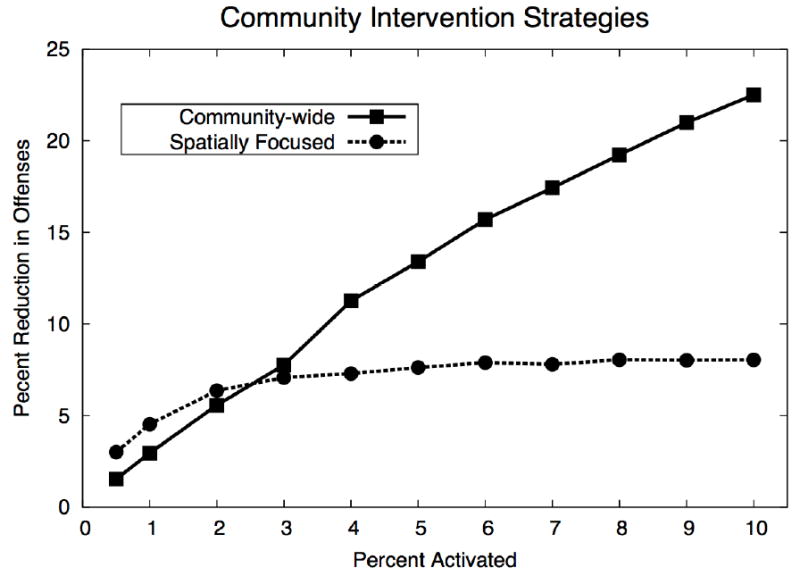
Spatially focused interventions reduce offenses slightly more than community-wide intervention if fewer than about 2.5% of adults are activated, but community-wide interventions provide a larger reduction in offenses for intervention that activate more than 3% of the adults in the community.
The results suggest that some target goals for interventions may not be achievable using spatially focused interventions alone. For example, if the goal of the intervention is to provide at least 4% reduction in offenses, then only community-wide interventions are effective in this model.
Cost-effectiveness of different community-level crime intervention approaches
Assuming that the cost of an intervention is proportional the percent of activated adults, the model shows that effectiveness per unit of cost generally decreases as the intervention intensity increases, but that the rates differ for community-wide and spatially focused interventions (see Fig. 6). Spatially focused interventions reduce offenses more cost-effectively than community-wide intervention if fewer than about 2.5% of adults are activated, but community-wide interventions provide a relatively constant reduction in offenses per unit cost for interventions that activate up to 10% of adults, whereas the cost-effectiveness of spatially focused intervention declines significantly as the intensity of the intervention increases. This reflects the decline in relative effectiveness when too many resources are focused on a single portion of the community.
Figure 6. Cost-Effectiveness of Community-wide and Spatially focused Interventions.
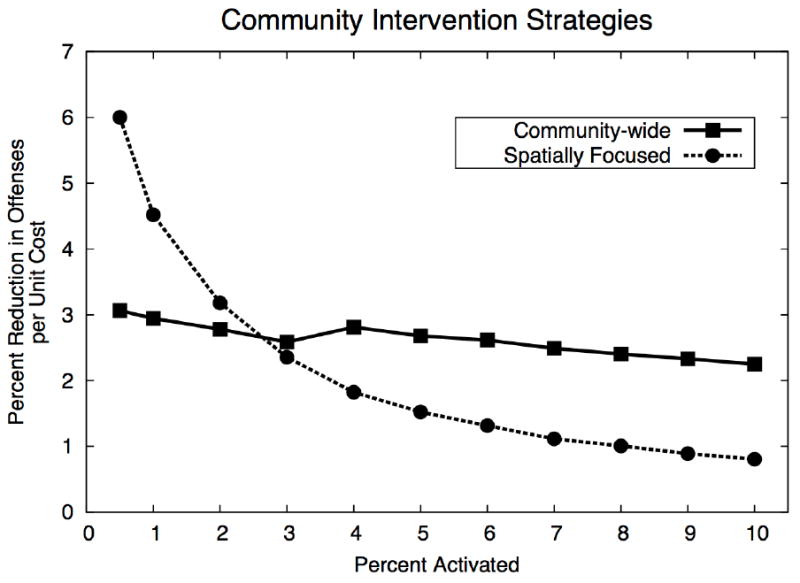
The figure shows the reduction in offenses per unit cost, assuming that the cost of an intervention is proportional the percent of activated adults. Spatially focused interventions reduce offenses more cost-effectively than community-wide intervention if fewer than about 2.5% of adults are activated, but community-wide interventions provide a relatively constant reduction in offenses for intervention that activate up to 10% of adults, whereas the cost-effectiveness of spatially focused intervention declines significantly as the intensity of the intervention increases.
Contagion
Table 2 presents results related to the spread or “contagion” of the offenses that results from community intervention. Entries in the table are bold if they represent a significant increase in contagion compared to no intervention. An entry in a spatially focused intervention is marked with an asterisk if it represents a significant increase in distance compared to the corresponding community-wide intervention.
Table 2. Contagion.
| Pct Activated | No Intervention | Community-wide | Spatially focused |
|---|---|---|---|
| 1 | 14.044 (2.130) | 15.687 (3.634) | 15.762 (4.817) |
| 2 | 14.044 (2.130) | 15.123 (2.700) | 18.186 (5.648)* |
| 3 | 14.044 (2.130) | 15.104 (2.245) | 20.597 (5.477)* |
| 4 | 14.044 (2.130) | 15.308 (2.059) | 20.754 (5.775)* |
| 5 | 14.044 (2.130) | 15.140 (2.065) | 22.657 (6.756)* |
| 6 | 14.044 (2.130) | 15.095 (1.721) | 22.639 (5.829)* |
| 7 | 14.044 (2.130) | 15.833 (2.020) | 22.039 (6.393)* |
| 8 | 14.044 (2.130) | 15.693 (2.050) | 24.007 (5.866)* |
| 9 | 14.044 (2.130) | 16.035 (2.008) | 23.073 (5.349)* |
| 10 | 14.044 (2.130) | 16.031 (1.930) | 22.375 (5.199)* |
Measured by the fraction of offenders who move from one block to another block between the time of intervention and the end of the simulation. Standard deviations are given in parentheses. In each row, the entries for the community-wide or spatially focused intervention are shown in bold if they represent a statistically significant (alpha = 0.05) increase in contagion compared to the control (No Intervention). An entry is marked with an asterisk if it represents a statistically significant increase in contagion compared to the alternative intervention.
At all intervention levels above 1% activated adults, the results show that spatially focused intervention has the effect of significantly increasing the movement of offenders, compared to both no intervention and community-wide interventions. Model visualizations show that with spatially focused interventions, offenders in the spatially focused block consistently move to a neighboring block and continue to offend. For community-wide interventions, the contagion effect is less pronounced. Overall, community-wide interventions produce less movement by offenders, because from the offender’s viewpoint there is little perceived advantage associated with any other location.
Sensitivity Analysis
The current model contains several parameters for which empirical data is currently unavailable, and thus it is important to ascertain the sensitivity of the result to these parameters. One important parameter is the density of the potential witness, that is, the ratio of the number of adults to the number of cells in the grid. The agent density affects the probability of an offense being witnessed and, therefore, the starting baseline against which we measure intervention effects. Furthermore, the agent density can also be expected to influence the point at which spatially focused intervention might lead to loss of cost-effectiveness due to overlapping witnesses. To explore the sensitivity of the result to agent density, variations of the models were created with 110% and 90% of the adult agents in the baseline model, and each such model was run for 50 replications for each intervention type and for each level of intensity. For all models, spatially focused interventions reduce offenses slightly more than community-wide intervention if fewer than about 2% of adults are activated, but community-wide interventions provide a larger reduction in offenses for intervention that activate more than 3% of the adults in the community. The general performance of both intervention strategies was consistent across the tested variations in the agent density. Results are shown in Fig. 7.
Figure 7. Sensitivity of Reduction in Offenses to Agent Density.
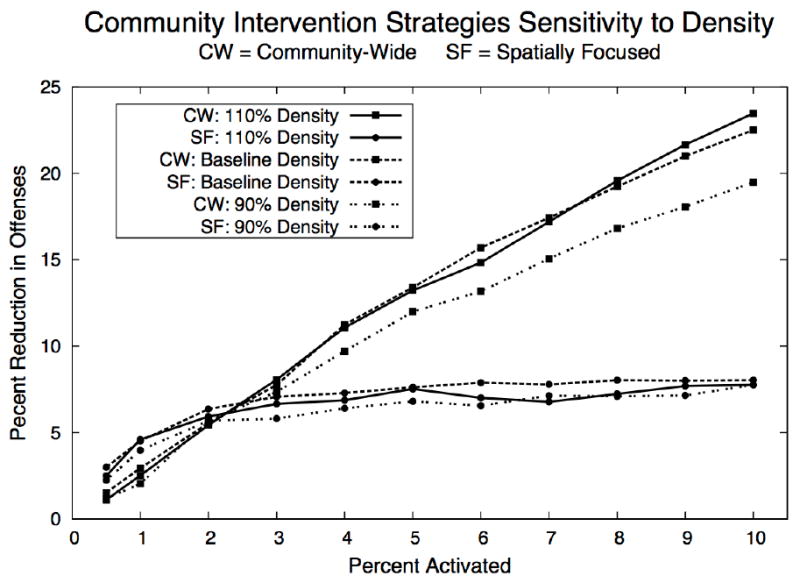
Models were created with 110% and 90% of the adult agents in the baseline model, and each modified model was run for 50 replications for each intervention type and for each level of intensity. For all models, spatially focused interventions reduce offenses slightly more than community-wide intervention if fewer than about 2% of adults are activated, but community-wide interventions provide a larger reduction in offenses for intervention that activate more than 3% of the adults in the community. The general performance of both intervention strategies was consistent across the tested variations in the agent density.
DISCUSSION
Computational simulation can serve as a feasible, flexible and collaborative tool for exploring community-level crime interventions. Agent based modeling served as an effective means for the conceptual dynamic simulation of community crime and potential impact of differing community-level crime interventions. The current conceptual model, despite its high level of abstraction, reveals interested trade-offs between alternative interventions. While spatially focused interventions may have an increased impact on reducing crimes committed by juvenile offenders when resources are extremely limited, such interventions are shown to consistently move/defer crime to nearby community settings. Community-wide interventions produce consistent and sustained reduction of community crime if resources are available for high intensity interventions. Because of the diminishing marginal returns associated with spatially focused interventions, some targets of overall crime reduction may require community-wide interventions. Of course, determining the exact value of the tipping point between interventions and the maximum level of effectiveness will require a more detailed model, but these results suggest that trade-offs in the spatial distribution of resources should be carefully considered when designing community interventions.
Previous ABMs have been developed to explore mitigation and dynamics of criminal activity but not the modeling of interventions (17-20). Epstein (2002) constructed an early ABM of civil violence and rebellion with agents having heterogeneous levels of grievance against central authority which produced a punctuated equilibrium, or periods of peace alternating with periods or rebellion. Groff (2008) developed an ABM of street robbery crimes and found that explicit geographic distributions reproduced crime patterns more similar to empirical patterns than other models. Our model is novel given the focus on crime-reporting behavior of citizens in a community experiencing crime. While interpretation is limited by the initial parameters, as it evolves our model parameters will be revised and adjusted to integrate additional complex data guided by academic and community input. The ability to examine model results in a matter of minutes is a practical alternative to the current process, time, cost and resources of having to examine active community-based crime and violence interventions.
As early as the 1940s, research within urban communities found that social and structural risk factors such as poverty, unemployment and residential instability were highly correlated with patterns of juvenile offending (Shaw, 1942). Many theoretical explanations have evolved to help characterize dynamics associated with community crime and violence. Social Disorganization Theory suggests that lack of community organization is an important missing resource within economically disadvantaged communities which challenges residents to maintain supervision of youth (Bursick RJ.; Webb J, 1982; Sampson et al., 1997; Shaw, 1942). Findings from this dynamic simulation reflect a growing body of evidence highlighting the importance of social connections and collective efficacy to address youth involved crime and violence (Beck, 2003; Cottrell, 1983; Sabol, Coulton, & Korbin, 2004; Sampson et al., 1997; Yonas, O’Campo, Burke, & Gielen, 2007). Findings provide support for the heterogeneous implementation of community crime prevention strategies such as community block watch programs which reduce the opportunities for crime through various mechanisms of social control (Holloway, 2008). Study finding strengthen support for Informal Social Control as a potential primary element to the success community interventions by enhancing community cohesion and ability to control crime (Greenberg, Rohe, Williams, National Institute of Justice (U.S.), & Research Triangle Institute., 1985).
As with any model there are a number of strengths and limitations we must highlight. The current early conceptual model represents an abstract simulation of the dynamic interactions associated with community crime that focuses only upon the interaction of juveniles and adult agents. As noted earlier, the model does not integrate many potentially important individual, social networks and law enforcement characteristics of community crime (e.g., police activities). For example, it is important to provide more realistic behavioral rules for agents that include social interactions among both adults (e.g., increasing community efficacy as a result of interventions) and juveniles (e.g., taking into account the effect of associates being arrested, as well as the dynamics of gang activities). Future iterations of the model will incorporate additional data such as specific characteristics of actual communities and city data (e.g., local population demographics, city boundaries and local crime statistics), types of crime and violence and law enforcement responses. In addition, the current model focused on how changes in a given percent of potential witnesses might affect overall crime patterns. Future models will also consider the mechanisms by which specific community interventions would in-fact change the behavior of the residents in the community, including the possibility of increasing the witnessing rate of residents, perhaps for a short period of time, rather than the complete “activation” considered in this early conceptual model. In summary, more detailed models are needed in order to predict specific levels of crime in specific communities.
In spite of this abstract model’s limitations, there are several strengths and novel elements worth noting. First, the model was calibrated with existing data thereby increasing the credibility of the baseline model and the observed intervention dynamics. Second, the model represents a novel application of agent-based modeling to examine decision-making behaviors related to community crime and crime interventions. Third, we believe that even an abstract model provides a potential cost effective tool for developing, piloting and tailoring community crime interventions. And finally, our interdisciplinary research team integrated the experience of public health, health behavior, biostatistics, computational science and community-based professional, providing support for using agent-based modeling as an innovative tool for cultivating community engaged and partnered research. Ongoing advice and guidance from community experts will aid in the development of more complex community models and the ability to simulate more realistic community crime interventions.
CONCLUSIONS
Findings demonstrate that community-wide and spatially focused intervention strategies cultivate unique intervention dynamics influencing juvenile crime behaviors as a result of the decisions and actions of community adults. This work illustrates how relatively simple, conceptual ABMs might be used to investigate community-supported crime intervention programs and provide a simulated setting for assessing practical dimensions of cost effectiveness comparison and intervention effect sustainability. The model results suggest that trade-offs in the spatial distribution of resources should be carefully considered when designing community interventions. Future plans include using the input of diverse academic, community, law enforcement and professional expertise to evolve this conceptual model into a more sophisticated model that can be used to help inform the design and selection of future community crime intervention programs.
Acknowledgments
This work was supported by the National Institute of General Medical Sciences MIDAS grant U54GM088491 and by the National Center for Advancing Translational Sciences of the National Institutes of Health under Award Number KL2TR000146. The content is solely the responsibility of the authors and does not necessarily represent the official views of the National Institutes of Health. The funders had no role in study design, data collection and analysis, decision to publish, or preparation of the manuscript. We would like to sincerely thank the peer reviewers for their thoughtful comments which greatly strengthened the manuscript.
References
- Ajzen I. Understanding attitudes and predicting social behavior. Englewood Cliffs, N.J.: Prentice-Hall; 1980. [Google Scholar]
- Beck L. Murder is no accident: Understanding and preventing youth violence in America. Library Journal. 2003;128(19):88–88. [Google Scholar]
- Bronfenbrenner U. The Ecology of Human Development. Cambridge, MA: Harvard University Press; 1979. [Google Scholar]
- Brown ST, Tai JHY, Bailey RR, Cooley PC, Wheaton WD, Potter MA, Lee BY, et al. Would school closure for the 2009 H1N1 influenza epidemic have been worth the cost?: a computational simulation of Pennsylvania. BMC Public Health. 2011;11 doi: 10.1186/1471-2458-11-353. [DOI] [PMC free article] [PubMed] [Google Scholar]
- Burke DS, Epstein JM, Cummings DA, Parker JI, Cline KC, Singa RM, Chakravarty S. Academic Emergency Medicine. 11. Vol. 13. Research Support, N.I.H., Extramural Research Support, Non-U.S. Gov’t; 2006. Individual-based computational modeling of smallpox epidemic control strategies; pp. 1142–1149. [DOI] [PubMed] [Google Scholar]
- Bursick RJ, Webb J. Community change and patterns of delinquency. American Journal of Sociology. 1982;88:24–42. [Google Scholar]
- Centers for Disease Control and Prevention Injury Prevention & Control: Data & Statistics (WISQARS) 2011 Retrieved Feb 10, 2012, from http://www.cdc.gov/injury/wisqars/
- Cottrell L. The competent community. In: Warren R, Lyon L, editors. New Perspectives on the American Community. Homewood, IL: Dozrsey Press; 1983. pp. 402–412. [Google Scholar]
- Dietz RD. The estimation of neighborhood effects in the social sciences: An interdisciplinary approach. Social Science Research. 2002;31(4):539–575. [Google Scholar]
- Dray AML, Perez P, Ritter A. Drug Law Enforcement in an Agent-Based Model: Simulating the Disruption to Street-Level Drug Markets. In: E J, Liu L, editors. Artificial Crime Analysis Systems. Hershey, PA: IGI Global; 2008. pp. 352–371. [Google Scholar]
- Ellickson PL, McCaffrey DF, Ghosh-Dastidar B, Longshore DL. New inroads in preventing adolescent drug use: results from a large-scale trial of project ALERT in middle schools. American Journal of Public Health. 2003;93(11):1830–1836. doi: 10.2105/ajph.93.11.1830. [Clinical Trial] [DOI] [PMC free article] [PubMed] [Google Scholar]
- Epstein JM. Proceedings of the National Academy of Sciences of the United States of America. Suppl 3. Vol. 99. Research Support, Non-U.S. Gov’t; 2002. Modeling civil violence: an agent-based computational approach; pp. 7243–7250. [DOI] [PMC free article] [PubMed] [Google Scholar]
- Furtado V, Melo A, Coelho ALV, Menezes R. Simulating Crime Against Properties Using Swarm Intelligence and Social Networks. In: L E, Liu J, editors. Artificial Crime Analysis Systems. Hershey, PA: IGI Global; 2008. pp. 300–318. [Google Scholar]
- Gorman DM, Mezic J, Mezic I, Gruenewald PJ. American Journal of Public Health. 11. Vol. 96. Research Support, N.I.H., Extramural; 2006. Agent-based modeling of drinking behavior: a preliminary model and potential applications to theory and practice; pp. 2055–2060. [DOI] [PMC free article] [PubMed] [Google Scholar]
- Greenberg SW, Rohe WM, Williams JR National Institute of Justice (U.S.), & Research Triangle Institute. Informal citizen action and crime prevention at the neighborhood level : synthesis and assessment of the research. Washington, DC: U.S. Dept. of Justice, National Institute of Justice; 1985. [Google Scholar]
- Groff E. Characterizing the spatio-temporal aspects of routine activities and the geographical distribution of street robbery. In: Liu L, Eck J, editors. Artificial Crime Analysis Systems. Hershey, PA: IGI Global; 2008. pp. 226–251. [Google Scholar]
- Holloway KBT, Farrington DP. US Department of Justice Office of Community Oriented Policing Services. Washington, D.C: 2008. Crime Prevention Research Review No 3: Does Neighborhood Watch Reduce Crime? [Google Scholar]
- Kellermann AL, Fuqua-Whitley DS, Rivara FP, Mercy J. Preventing youth violence: What works? Annual Review of Public Health. 1998;19:271–292. doi: 10.1146/annurev.publhealth.19.1.271. [Review] [DOI] [PubMed] [Google Scholar]
- Lee BY, Brown ST, Bailey RR, Zimmerman RK, Potter MA, McGlone SM, Burke DS, et al. The Benefits To All Of Ensuring Equal And Timely Access To Influenza Vaccines In Poor Communities. Health Affairs. 2011;30(6):1141–1150. doi: 10.1377/hlthaff.2010.0778. [DOI] [PMC free article] [PubMed] [Google Scholar]
- Lee BY, Brown ST, Cooley P, Potter MA, Wheaton WD, Voorhees RE, Burke DS, et al. J Public Health Manag Pract. 3. Vol. 16. Research Support, N.I.H., Extramural; 2010. Simulating school closure strategies to mitigate an influenza epidemic; pp. 252–261. [DOI] [PMC free article] [PubMed] [Google Scholar]
- Lee BY, Brown ST, Cooley PC, Zimmerman RK, Wheaton WD, Zimmer SM, Burke DS, et al. A Computer Simulation of Employee Vaccination to Mitigate an Influenza Epidemic. American Journal of Preventive Medicine. 2010;38(3):247–257. doi: 10.1016/j.amepre.2009.11.009. [DOI] [PMC free article] [PubMed] [Google Scholar]
- Lee BY, Brown ST, Korch GW, Cooley PC, Zimmerman RK, Wheaton WD, Burke DS, et al. A computer simulation of vaccine prioritization, allocation, and rationing during the 2009 H1N1 influenza pandemic. Vaccine. 2010;28(31):4875–4879. doi: 10.1016/j.vaccine.2010.05.002. [DOI] [PMC free article] [PubMed] [Google Scholar]
- Mulvey EP, Steinberg L, Fagan J, Cauffman E, Piquero AR, Chassin L, Losoya SH, et al. Theory and Research on Desistance from Antisocial Activity among Serious Adolescent Offenders. Youth Violence Juv Justice. 2004;2(3):213. doi: 10.1177/1541204004265864. [DOI] [PMC free article] [PubMed] [Google Scholar]
- Office of the Surgeon General (US); National Center for Injury Prevention and Control (US); National Institute of Mental Health (US); Center for Mental Health Services (US) Youth violence: a report of the surgeon general. Rockville, MD: Office of the Surgeon General; 2001. [PubMed] [Google Scholar]
- Puzzanchera C. Juvenile Arrests 2007. Juvenile Justice Bulletin. 2009:1–11. Retrieved from www.ncjrs.gov/pdffiles1/ojjdp/225344.pdf.
- Resnick MD, Ireland M, Borowsky I. J Adolesc Health. 5. Vol. 35. Research Support, U.S. Gov’t, Non-P.H.S.; 2004. Youth violence perpetration: what protects? What predicts? Findings from the National Longitudinal Study of Adolescent Health; pp. 424 e421–410. [DOI] [PubMed] [Google Scholar]
- Sabol WJ, Coulton CJ, Korbin JE. Building community capacity for violence prevention. J Interpers Violence. 2004;19(3):322–340. doi: 10.1177/0886260503261155. [DOI] [PubMed] [Google Scholar]
- Sampson RJ, Raudenbush SW, Earls F. Science. 5328. Vol. 277. Research Support, Non-U.S. Gov’t; 1997. Neighborhoods and violent crime: a multilevel study of collective efficacy; pp. 918–924. [DOI] [PubMed] [Google Scholar]
- Shaw C, McKay HD. Juvenile Delinquency and Urban Areas. A Study of the Rates of Delinquency in Relation to Differential Characteristics of Local Communities in American Cities. Chicago: University of Chicago Press; 1942. [Google Scholar]
- Yonas MA, O’Campo P, Burke JG, Gielen AC. Health Educ Behav. 4. Vol. 34. Research Support, U.S. Gov’t, P.H.S.; 2007. Neighborhood-level factors and youth violence: giving voice to the perceptions of prominent neighborhood individuals; pp. 669–685. [DOI] [PubMed] [Google Scholar]


